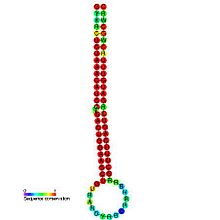- mir-30 microRNA precursor
-
mir-30 microRNA precursor 
Predicted secondary structure and sequence conservation of mir-30 Identifiers Symbol mir-30 Rfam RF00131 miRBase MI0000088 miRBase family MIPF0000005 Other data RNA type Gene; miRNA Domain(s) Eukaryota GO 0035068 0035195 SO 0001244 miR-30 microRNA precursor is a small non-coding RNA that regulates gene expression. Animal microRNAs are transcribed as ~70 nucleotide stem-loop precursor and subsequently processed by the Dicer enzyme to give a mature ~22 nucleotide product. In this case the mature sequence comes from both the 3' (miR-30)[1] and 5' (mir-97-6)[2] arms of the precursor. The products are thought to have regulatory roles through complementarity to mRNA [3].
A screen of 17 miRNAs that have been predicted to regulate a number of breast cancer associated genes found variations in the microRNAs miR-17 and miR-30c-1, these patients were noncarriers of BRCA1 or BRCA2 mutations, lending the possibility that familial breast cancer may be caused by variation in these miRNAs.[4]
Members of the miR-30 family have been found to be highly expressed in heart cells.[5]
Contents
Targets of miR-30
It has been shown that the integrin ITGB3 and the ubiquitin conjugating E2 enzyme UBC9 are downregulated by miR-30.[6] It has also been suggested that the TP53 protein may be a target of miR-30c and miR-30e. An immunoblot analysis revealed that p53 expression levels were elevated upon knockdown of miR-30c and miR-30e.[7]
References
- ^ Lagos-Quintana, M; Rauhut R, Lendeckel W, Tuschl T (2001). "Identification of novel genes coding for small expressed RNAs". Science 294 (5543): 853–858. doi:10.1126/science.1064921. PMID 11679670.
- ^ Mourelatos, Z; Dostie J, Paushkin S, Sharma A, Charroux B, Abel L, Rappsilber J, Mann M, Dreyfuss G (2002). "miRNPs: a novel class of ribonucleoproteins containing numerous microRNAs". Genes Dev 16 (6): 720–728. doi:10.1101/gad.974702. PMC 155365. PMID 11914277. http://www.pubmedcentral.nih.gov/articlerender.fcgi?tool=pmcentrez&artid=155365.
- ^ Ambros V (2001). "microRNAs: tiny regulators with great potential". Cell 107 (7): 823–6. doi:10.1016/S0092-8674(01)00616-X. PMID 11779458.
- ^ Shen J, Ambrosone CB, Zhao H (2009). "Novel genetic variants in microRNA genes and familial breast cancer". Int J Cancer 124 (5): 1178–82. doi:10.1002/ijc.24008. PMID 19048628.
- ^ Duisters RF, Tijsen AJ, Schroen B, et al. (January 2009). "miR-133 and miR-30 regulate connective tissue growth factor: implications for a role of microRNAs in myocardial matrix remodeling". Circ. Res. 104 (2): 170–8, 6p following 178. doi:10.1161/CIRCRESAHA.108.182535. PMID 19096030.
- ^ Yu F, Deng H, Yao H, Liu Q, Su F, Song E (July 2010). "Mir-30 reduction maintains self-renewal and inhibits apoptosis in breast tumor-initiating cells". Oncogene 29 (29): 4194–204. doi:10.1038/onc.2010.167. PMID 20498642.
- ^ Li J, Donath S, Li Y, Qin D, Prabhakar BS, Li P (January 2010). McManus, Michael T.. ed. "miR-30 regulates mitochondrial fission through targeting p53 and the dynamin-related protein-1 pathway". PLoS Genet. 6 (1): e1000795. doi:10.1371/journal.pgen.1000795. PMC 2793031. PMID 20062521. http://www.pubmedcentral.nih.gov/articlerender.fcgi?tool=pmcentrez&artid=2793031.
Further reading
- Agrawal R, Tran U, Wessely O (December 2009). "The miR-30 miRNA family regulates Xenopus pronephros development and targets the transcription factor Xlim1/Lhx1". Development 136 (23): 3927–36. doi:10.1242/dev.037432. PMC 2778741. PMID 19906860. http://www.pubmedcentral.nih.gov/articlerender.fcgi?tool=pmcentrez&artid=2778741.
External links
miRNA precursor families 1-100 101-200 201+ Other Categories:- MicroRNA
- Molecular and cellular biology stubs
Wikimedia Foundation. 2010.
